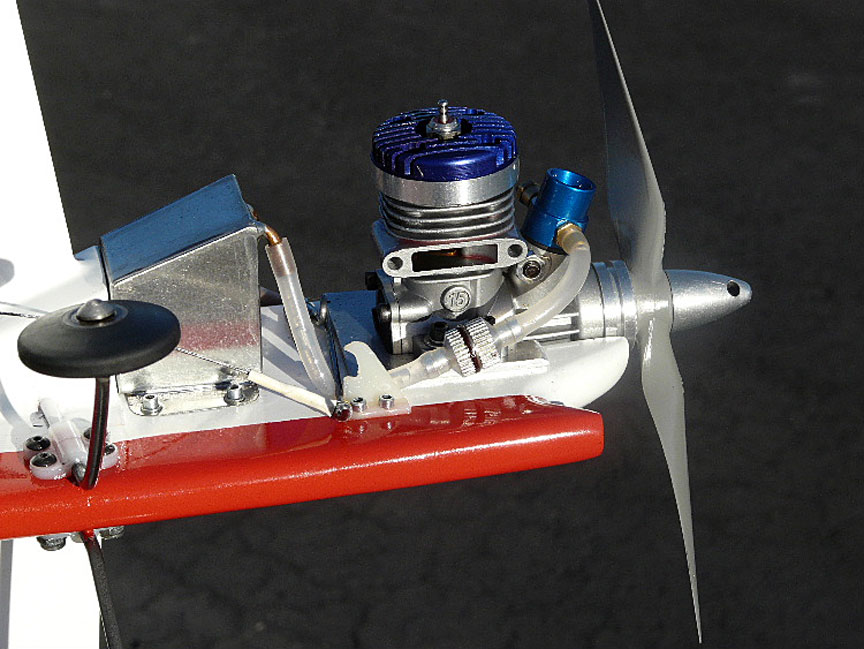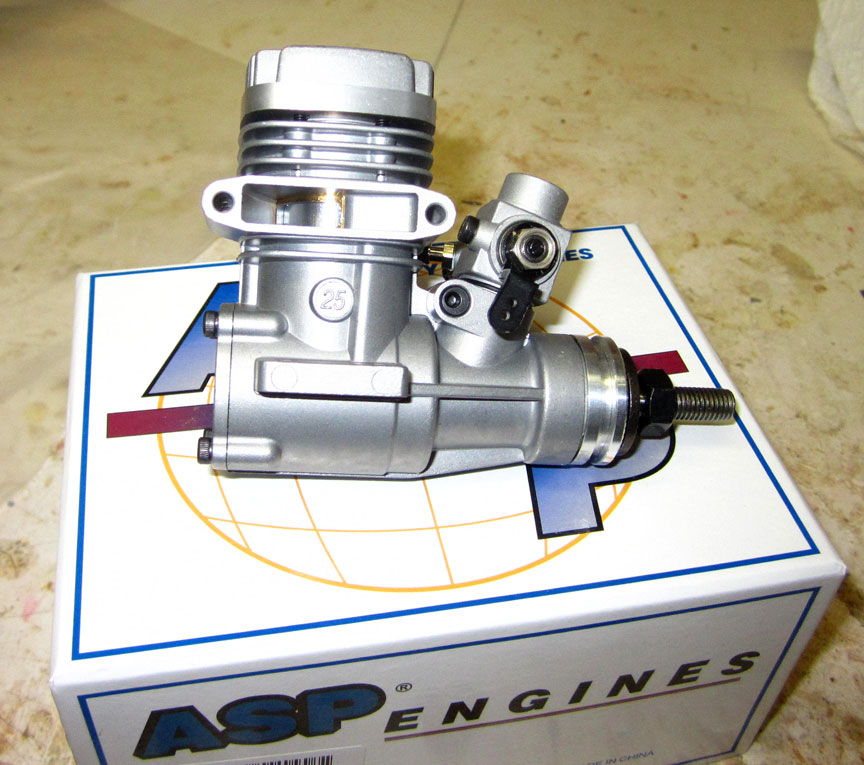A View from Broadway
Three in one? Or ...
The ASP .25 engine, now legal for Northwest Sport Race. All photos by Ken Burdick.
Which engine is best for Northwest Sport Race?
And -- a word about shutoffs
By Ken Burdick
Yes Folks, it’s true.
There has been a recent vote that approved the ASP .25 into the allowable engines for Northwest Sport Race.
The original engine was of course the venerable Fox .35 Stunt, followed by a more recent addition of the O.S. LA .25. Of the three, the ASP is the only one currently in production. Let’s have a look at this low-cost sport engine and see how it stacks up to the others.
ASP Initial impressions
The ASP .25 broken down, with the addition of the Evolution 6mm venturi, which converts the engine for control-line use at the allowable intake for Northwest Sport Race. The supplied RC carburetor also can be used (see Northwest Sport Race Rules for details).
The ASP .25 appears to be a sport engine, but on closer inspection is quite a bit more. It is well thought-out in design with many nice features. At first, I thought it was another LA knock-off. That all ended when I opened up the ASP. I was encouraged that the head and backplate bolts were not soft Philips-head machine screws that round out with the slightest torque, but real hex-head 2mm hardened machine screws. Let’s take this thing apart and discover it together, okay?
Cylinder head
The cylinder head is a pressure cast shallow hemi dome with a narrow squish band (.133 wide) and seals with .003 aluminum gasket. Adequate head fins will keep this one cooler than many. I was impressed with the tight fit between the head and liner. The head is set .030 above the piston with the .003 gasket installed. It compares slightly with the LA .25 only in its shape. The squishband is narrower and the depth of the edge of the chamber to the glow plug is slightly shallower.
Piston and liner
The liner is brass with what appears to be hard chrome plating. Porting is a three-port intake with a main port angled up at the head and two boost ports angled to the side, similar to the O.S. FP series.
The exhaust port is positioned in the case similar to the LA .25. This port arrangements allow a smooth fuel entry to the ports.
All liner ports look to be deburred, the chrome has very fine honing and the piston fit seems a bit lose but tightens up at the last .300 of travel, which is what we want. The piston is a hard aluminum alloy.
The engine sports a nicely made conrod bushed at the top and bottom with two oiling holes in the bottom and one in the top. The wrist pin is kept in place with a single circlip and a smaller hole on the opposite side of the piston to keep the pin from working its way out. Lastly, the liner is notched for a pin pressed into the crankcase for proper alignment to the crankcase ports. Some these features are missing on the LA series.
Crankcase

A close look at the crankcase.
A nice-looking pressure casting with the ports twisted similar to the LA design. What the ASP has that the LA does not, is a clean transition to the ports from the bottom of the crankcase. I have spent hours on my LA .25 doing this by hand for NW B Proto.
I like the arrangement of the carburetor hold-down. It is at the very rear of the air intake (similar to Italian engines) this means that a spray bar can be placed in this hole with just the fuel outlet exposed and saving all that area normally taken up by the spray bar, I am not sure this will work for our suction application, but more on this later.
Crankshaft

The crankshaft and the other parts aside from the crankcase.
I do not have the tools to tell you how hard this crank is, but it appears to be chrome steel.
The counterweight is nicely machined, reminiscent of the G21 Super Tigres.
The crankshaft has an adequate 10mm hole and is held by two ball bearings. The good news is the bearing retainer in the rear is nylon so no worries about exploding metal race tabs blowing apart and ruining your engine. The front bearing has a shield keeping and ever-present dirt away.
The crankshaft in my engine seems a bit tight, but there is no sign of rubbing in the case so a little polishing to refit it into the bearings may be in order. One thing I can say is the forward portion of the crank port aligns pretty well with the air intake, making it a smooth transition to the engine. In many engines I have recontoured this with JB Weld, but this looks pretty good.
Backplate
The pressure cast aluminum backplate is deep into the case and seals with plastic gasket. A small piston relief is cast in, and a reasonably tight fit into the case, best of all it’s not plastic.
Timing
Timing disclaimer:
This information as reference only, your numbers may vary. The timing is mild but just what is needed for our sport racing application.
Deck Height |
0.0035 |
Stroke / 2 |
0.3550 |
Rod/Stroke Ratio |
1.6549 |
Engine Displacement |
0.2787 |
Swept Volume from Exhaust Closing |
0.2187 |
Blow Down (DEG) |
13.64 |
Blow Down (Inches) |
0.0585 |
Exhaust Port Values |
|
Distance ATC |
0.5570 |
Distance BBC (Port HGT) |
0.1530 |
Port Duration (DEG) |
127.07 |
Piston ATC (DEG) |
116.47 |
Piston BBC (DEG) |
63.53 |
Transfer Port Values |
|
Distance ATC |
0.6155 |
Distance BBC (Port HGT) |
0.0945 |
Port Duration (DEG) |
99.79 |
Piston ATC (DEG) |
130.11 |
Piston BBC (DEG) |
49.89 |
Inlet (Crank Port or Rotor) Values |
|
Port Opens ABC (DEG Crank Port or Rotor) |
38.26 |
Port Opens BTC (DEG Crank Port or Rotor) |
141.74 |
Port Close ATC (DEG Crank Port or Rotor) |
64.78 |
Total Intake Timing (DEG Crank Port or Rotor) |
206.52 |
Engine test runs
It’s 10 degrees C here in Kamloops, B.C., so guess what -- no test runs.
So, there you have it lil' geezers, I give the nod to the ASP for design improvements over the LA .25. It looks to be a well-thought-out engine with the best bang for the buck. It also uses hard chrome and not nickel plating on the liner.
So far, we know the testing that Gene Pape has done shows the ASP to be every bit as fast as the LA.25 when using a 6mm venturi. This engine is capable of much more speed so the restricted venturi keeps things even. Some additional testing was done recently showing that the R/C carburetor put in the wide-open position was 100 rpm faster than the 6mm Evolution venturi with an O.S. needle valve and spray bar.
Price wise, you will pay something between $75-$100 for a new LA .25 on eBay if you can find one. The ASP .25 will cost around $50 if purchased from Hobby King. You will need to figure out a 6mm venturi and needle valve for it, or simply wire the supplied carburetor to its open position. I could find no spare parts for this engine, but the price of $50 is so low that an extra engine could be purchased for spares.
Gene Pape found a simple solution for a verturi from Horizon Hobbies, and it fits perfectly.
So, Geezers, if you are wanting to be competitive in Northwest Sport Race, tie one of the ASP .25’s onto that Ringmaster and watch it go just as fast as the best out there. The engine is capable of speeds in excess of 100 mph with the venturi removed and a pressure system employed. This makes it a low-cost alternative for 80 mph combat.
Turn it off, man!
The recent vote also approved the use of shutoffs for Northwest Sport Race. You can build your own or buy a commercially made unit.

This shutoff diagram comes from Bill Bischoff. He will sell the wire for $1. The rest is pretty easy. Below are two photos of a plane with a shutdoff installed.


-- Kennyb
Back to Bod Busters main page
Back to racing main page
Flying Lines home page
This page was upated Jan. 28, 2018


